|
|
|
Sort Order |
|
|
|
Items / Page
|
|
|
|
|
|
|
| Srl | Item |
| 1 |
ID:
162962


|
|
|
|
|
| Summary/Abstract |
Energy efficiency standards have crucial roles in reducing the energy consumption of room air conditioners (RACs) in many countries around the world. In this paper, a review of the policy rules of energy efficiency standards is presented. The characteristics and rationality for the evaluation metrics in various countries are analyzed. The difference between the energy efficiency standards for RACs in China and those for other countries are discussed. The development trends for the energy efficiency standards of Chinese RACs are provided in this paper. The division of temperature zones, various operation modes and the long-term performance of RACs should be considered when establishing the energy efficiency standards of RACs. Note that the improvement in the energy efficiency standards of RACs is a vital measure for energy conservation and environmental protection. Therefore, the environmental impact of the energy efficiency standards for RACs with refrigerants will become a major direction in the enhancement of future standards of RACs. Finally, two methods based on a logarithmic function and a linear function are proposed in this paper, which combine global warming potential (GWP) and energy efficiency evaluation metrics. This paper will significantly contribute to the formulation and revision of the energy efficiency standards of RACs and provide guidance to manufacturers of air conditioners.
|
|
|
|
|
|
|
|
|
|
|
|
|
|
|
|
| 2 |
ID:
162951


|
|
|
|
|
| Summary/Abstract |
The aim of this study is to assess the offshore wind and solar power and to determine whether the future power supply in Taiwan will be stable. The estimated annual offshore wind and solar power generation for 2030 are 11343 GWh and 11367 GWh, respectively. Based on these results, it appears that the annual power supply can easily help balance the total power demand. However, the power demand is high during the summer peak months, and power generation may be insufficient during peak summer hours by 2030. Specifically, in 2024, the peak hourly percent reserve margin (PRM) in summer will be negative (-0.9%). If the installation of offshore wind turbines and solar panels is delayed, then the problem of insufficiency will be even more severe. However, if the offshore wind and solar photovoltaic projects are completed on schedule, and the first, second, and third nuclear power plants (NPPs) extend their service to 2030, then the hourly PRM could reach 15% during the summer peak hours from 2025 to 2030 and 5–11% in the other years. Moreover, if the fourth NPP opens, then the estimated summer peak hourly PRM would increase by 6–7%.
|
|
|
|
|
|
|
|
|
|
|
|
|
|
|
|
| 3 |
ID:
162944


|
|
|
|
|
| Summary/Abstract |
The use of auctions for determining the level of renewable energy remuneration is increasing. A cause for concern is the resulting potential to exclude smaller investors from the market, in particular community energy projects. However, empirical evidence and examination of resulting consequences have been insufficient so far. This article analyses the effects a shift from guaranteed remuneration to auctions might have on incentives to start new community wind projects, analysing the case of Germany. It thus contributes to research on investor-specific impacts of renewable energy policy instruments. An explanatory sequential mixed-method design was applied, combining surveys and interviews for the collection of expert assessments. The developed typology allows the assessment of the respective potential of different wind project types for procedural and distributive justice, which are understood to support local acceptance. Wind projects developed by the local community were found to be most beneficial for local acceptance, but appear to face the highest challenges in auctions. A crowding out of these projects would be particularly unfortunate with regard to the need to expand wind energy capacities much more. It is recommended that policy makers ensure a level playing field, also within the context of auctions, for wind projects developed by the local community.
|
|
|
|
|
|
|
|
|
|
|
|
|
|
|
|
| 4 |
ID:
162972
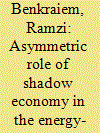

|
|
|
|
|
| Summary/Abstract |
This paper estimates the energy demand function to examine the asymmetric relationship between the shadow economy and energy consumption in the case of Bolivia during the period of 1960–2015. The ambiguous empirical findings on shadow economy-energy demand nexus has inclined us to apply the nonlinear ARDL cointegration approach developed by Shin et al. (2014) and the Hatemi-J (2012) asymmetric causality test. The empirical evidence confirms the presence of an asymmetric relationship between the variables of interest. Positive and negative shocks to official GDP (true GDP) and the shadow economy have positive impacts on energy consumption. Energy consumption is positively and negatively affected by positive and negative shocks in financial development, respectively. A positive (negative) shock to capital decreases energy consumption. Another important finding concerns the complex causal direction between economic growth and energy consumption. This study provides new insights regarding to the use of official GDP (true GDP) and the shadow economy as economic tools to maintain energy demand for sustainable economic development.
|
|
|
|
|
|
|
|
|
|
|
|
|
|
|
|
| 5 |
ID:
162973


|
|
|
|
|
| Summary/Abstract |
Regions that produce and export fossil fuels experience strong carbon lock-in. Yet, successful fossil fuel sectors also equip a region with skills and resources that could promote the development of certain low-carbon technologies. This paper considers potential complementarities between the oil and gas sector and low-carbon geothermal energy technologies in Alberta, Canada. We find that resources from oil and gas could enable the development of geothermal technologies because of similarities in areas such as actor skills, policy institutions, political networks, sub-surface information, and physical infrastructure. We also present an improved conceptual framework to study socio-technical complementarities based on the technological innovation systems (TIS) approach. Our framework allows for a more active search for unexploited opportunities to develop a new technology within a given regional or sectoral context and highlights the possibility for system complementarity failures.
|
|
|
|
|
|
|
|
|
|
|
|
|
|
|
|
| 6 |
ID:
162974


|
|
|
|
|
| Summary/Abstract |
This study investigates from a socio-technical perspective the emergence of Solar Photovoltaic electricity (PV) in Brazil and identifies challenges and opportunities of PV energy in the country. The research is based mainly on primary data from 2015 to 2016 including 15 in-depth interviews with representing relevant actors from the system. Additional written data involved resolutions, regulations and reports from the official government organizations. Multilevel perspective and the functions of innovation systems perspective were used for data analysis. The need for the dissemination of PV energy includes the establishment of long-term clear goals, fiscal and financial incentives, more attractive opportunities for investors as well as professional training courses. The paper includes a critical review of the applicability of the multilevel perspective and functions of innovation system with recommendations for adapting them to better fit this case. What is especially interesting to derive from the analysis is the impact of the niche developments on the regime and the landscape, especially in the establishment of a domestic PV energy industry, national economic growth, local and regional development, which would result from the dissemination of PV energy.
|
|
|
|
|
|
|
|
|
|
|
|
|
|
|
|
| 7 |
ID:
162931


|
|
|
|
|
| Summary/Abstract |
The electricity supply industry in the United Kingdom underwent a number of regulatory reforms since late 80's that have transformed the trading and pricing of the energy market. Herein we provide empirical evidence that the Modification Proposal P12 (Mod P12) - that took place in 7/2/2002 - moving the Gate Closure (GC) interval from 3.5 h to 1 h before real time has caused a permanent alteration in the UK spot price volatility. Using a combination of Recurrence Plot (RP) and Recurrence Quantification Analysis (RQA) we find that, after the the change in the GC time, short term price volatility significantly decreased between 2001 and 2008 while long term price volatility is not affected by CG change. Similar results are obtained by means of spectral analysis on the price series, showing a significant reduction in its variability. The results of our analysis suggest that a dynamical regime shift of the price occurred, and such shift is linked to the GC change whereby shorter GC intervals facilitate short-term forecasting on electricity demand and better reliability on the supply side. Therefore, GC closer to real time is associated to reduced price fluctuations in the wholesale market.
|
|
|
|
|
|
|
|
|
|
|
|
|
|
|
|
| 8 |
ID:
162945
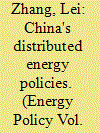

|
|
|
|
|
| Summary/Abstract |
Distributed energy (DE) is a way to cascade energy use near multiple users. It significantly impacts energy savings, emission reductions and energy structure upgrades. In recent years, all levels of the Chinese government have strived to introduce policies favorable to the implementation of DE. These policies have been affected by the timing of the introduction, regional economic differences, the degree of government attention, and many other complex factors. To clarify the development and links between these policies, this study summarizes and compares China's DE policies at national, provincial, and municipal levels, from 1989 to 2016. We analyze the scope and content of subsidies in detail, and then provide policy recommendations for DE development in China. The main results are as follows: (1) DE policies emerge from legal provisions in the areas of energy, electricity, and environmental protection. The policies have gradually evolved from macro-plans to specific guidance. (2) The demand for DE subsidies is increasing, making the back slope of subsidies significant under an insufficient government budget. Diverse subsidies are needed to address this contradiction. (3) Future policies should focus on comprehensive DE utilization, smart grids, research and development (R&D), and developing policy synergies at different levels.
|
|
|
|
|
|
|
|
|
|
|
|
|
|
|
|
| 9 |
ID:
162946
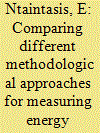

|
|
|
|
|
| Summary/Abstract |
This paper uses and comparatively evaluates objective, subjective and composite indicators for measuring and analyzing energy poverty in Attika Region, Greece. The necessary data for the quantification of these indicators were gathered through a survey involving 451 households. The results of the analysis showed that the measurement of energy poverty based on classical objective and subjective indices leads to divergent results, which in addition have little relevance to each other. To a large extent, households characterized as energy poor by one method are not classified as such with another. The use of composite indicators adjusted to local circumstances seems to form a more coherent framework for measuring energy poverty in an area and may provide additional information as regards the intensity of energy poverty. The implementation of the two composite indicators developed in the context of this study showed that energy poverty levels in the region of Attica range between 37% and 43.5%. About 27.5% of the households are energy poor with both composite indicators, while the 11.5% of households are characterized by high energy poverty intensity. Also, the analysis of the characteristics of the energy poor households provides useful insights for developing appropriate policies to tackle the problem.
|
|
|
|
|
|
|
|
|
|
|
|
|
|
|
|
| 10 |
ID:
162943


|
|
|
|
|
| Summary/Abstract |
Cost efficient deployment of wind energy is in focus for reaching ambitious targets for renewable energy and transforming the energy supply to one based on renewables. However, as more wind is being deployed the available sites onshore become less attractive in terms of wind conditions and capacity factor and more resistance from population groups affected in the deployment areas results in a reduction of areas that can be developed. We consider three different methods for estimating acceptance costs, one based on compensation and property purchase costs, one based on property value loss near wind turbines, and one based on willingness to pay calculated from a stated preference study. Utilising these methods, we provide an estimation of Levelised Cost of Energy (LCOE) for an expansion of 12 GW onshore or offshore wind capacity in Denmark. We find that the three methods provide similar estimates for local acceptance, but that a high range of uncertainty exists in the upper bound of acceptance costs. Onshore does not have a clear-cut cost advantage over offshore when considering substantial amounts of wind capacity expansion and using high estimates for nation-wide acceptance costs. Moderate onshore wind expansion considering only local acceptance has a cost advantage.
|
|
|
|
|
|
|
|
|
|
|
|
|
|
|
|
| 11 |
ID:
162949
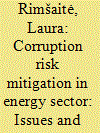

|
|
|
|
|
| Summary/Abstract |
Background of the research is that corruption issues arising in the energy sector strongly depends on the location of the resources as well as the monopolistic nature of the undertakings or political decisions. The participation at the public procurement tenders result the information exchange between the competitors therefore lead to the market closure and increased prices for the end-users. Enforcement of anti-corruption laws have risen, including the imposition of huge fines for the enterprises, and prison sentences for offending corporate executives. The purpose of this article is to analyse and evaluate the factors resulting corruption actions in the energy sector and to reveal the intercourse between the competition law regulation and corruption regulation. The data collection, systemic review and other methods were used. Key findings reveal that corruption occurs due to the specifics of the sector as the resource location, politics, and public procurement. Significance of this research is high due to increased impact of the energy resources to daily life and the monopolistic undertakings resulting high prices to the consumers. Recommendations to minimise the corruption probability highlights the importance of the increased level of transparency and prevention mechanisms especially in the vulnerable areas.
|
|
|
|
|
|
|
|
|
|
|
|
|
|
|
|
| 12 |
ID:
162930


|
|
|
|
|
| Summary/Abstract |
Energy and heat cross-subsidies are common in developing and transitioning countries, but the distributional and efficiency impacts of these policies (and reform) are largely unknown. In Post-Soviet countries such as Belarus, revenues from an industrial tariff on electricity are used to cross-subsidize heating for households. We analyze the distributional impacts of cross-subsidy reform with both input output methods and a calibrated static computable general equilibrium (CGE) model with heterogeneous households based on a household consumption survey. On average, GDP gains of roughly a quarter of a percent are computed across model runs which reduce taxes and subsidies from cross-subsidization. Reducing household heating subsidy rates equally across income groups is found to be regressive. Poorer households are overly-burdened due to higher heating expenditures while richer households enjoy gains from cheaper market prices for goods. The GDP gains are even larger when the tax rates are structured to create a distributionally-neutral reform.
|
|
|
|
|
|
|
|
|
|
|
|
|
|
|
|
| 13 |
ID:
162958


|
|
|
|
|
| Summary/Abstract |
We analyze to what extent electricity production by non-fossil fuel replaces fossil fueled electricity production in 27 OECD-countries 1980–2014. Depending on model specification, the long run replacement coefficient is in the range of minus 0.4–1.0, which is considerably larger than found in other studies. This means that an increase in non-fossil fuel based electricity production by 10 kWh/capita replaces fossil fuel based production in the range 4–10 kWh/capita. Over all the estimated replacement is not sufficient to prevent economic growth from increasing fossil based electricity production, thus eating up environmental improvements. However, we identify two important exceptions to this. First, countries with a ‘low’ level of fossil based production have an Environmental Kuznets Curve (EKC) relationship when we allow for separate effects of the economic downturn after the Great Recession 2008–2009. Second, results for the EU countries indicate that the EU Emission Trading System, and possibly EU country specific policy instruments, have influenced the mix of electricity production in the intended direction.
|
|
|
|
|
|
|
|
|
|
|
|
|
|
|
|
| 14 |
ID:
162938


|
|
|
|
|
| Summary/Abstract |
Limited access to transmission grids can be a potential barrier that prevents the wind power development. Unbundling transmission operation and ownership from incumbents was a common approach for greater competition in the United States and European countries, before promoting renewable energy deployment. This article investigates whether the functional separation of transmission in the United States enhanced the wind power installation. I employ the OLS fixed effect and Tobit random effect models to separately examine the effects of state policies and socio-economic factors, using panel data from 1990 to 2016. This study shows that the functional unbundling, an omitted variable in prior econometric studies, emerges as a main driver of state wind power development. The result indicates states in Independent System Operator or Regional Transmission Operator develops annually about 46.8% (Tobit) to 118% (OLS) more wind capacity on average. This paper suggests removing barriers for competition can facilitate wind energy development as a side effect in the United States, especially for nonutility.
|
|
|
|
|
|
|
|
|
|
|
|
|
|
|
|
| 15 |
ID:
162970
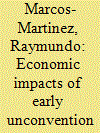

|
|
|
|
|
| Summary/Abstract |
Globally, the development of the unconventional natural gas (UNG) industry is expected to continue as gas consumption increases in the transition to cleaner energy sources. However, social and regulatory factors may constrain UNG activity at regional scales. Robust impact assessments of the effects of the UNG industry at different phases of development could help reduce trade-offs of energy policy and promote overall welfare improvements. We assessed if the early phases of the coal seam gas (CSG, a type of UNG) industry in New South Wales, Australia produced regional economic changes between 2001 and 2011. We combined spatial econometrics, genetic matching algorithms and seemingly unrelated regressions with instrumental variables to control for multiple factors influencing regional economic patterns (e.g., climate, human capital) to estimate the effect of the CSG industry on local income and employment. Results show that regions with CSG activity had 7% (±5%, 95% C.I.) higher family income than regions without CSG mining. No statistical evidence of indirect employment multiplier effects from CSG activity were found. The analysis can inform social license and regulatory decisions related to the CSG industry that impact competing social priorities such as energy and water security, economic growth and environmental health.
|
|
|
|
|
|
|
|
|
|
|
|
|
|
|
|
| 16 |
ID:
162956


|
|
|
|
|
| Summary/Abstract |
To study the effect of the air pollution charging fee (APCF) policy on the haze pollution in China, a dynamics management model is constructed with the approach of system dynamics and implemented by using the Vensim software. This model is used to simulate and assess the effect of APCF policy on the traffic and the emissions (particularly carbon monoxide (CO), hydrocarbons (HC), nitrogen oxides (NOx), and particulate matter (PM)) in Beijing during the years 2011–2025 in different scenarios. The validity and the robustness of the model are verified by a model test and validation, and a reasonable range of APCF is determined by using a sensitivity analysis. The simulation results showed that the APCF policy effectively realized the “win-win” scenario of emission reduction and congestion release. In particular, the simulation results also indicated some policy effects such as rebound effect (from low-APCF policy), inflection-point effect (from high-APCF policy), and marginal decreasing effect (between moderate and high-APCF policy). These results provide some valid policy recommendations for energy management and emission reduction.
|
|
|
|
|
|
|
|
|
|
|
|
|
|
|
|
| 17 |
ID:
162960


|
|
|
|
|
| Summary/Abstract |
Taiwan aims to replace all nuclear power with renewable energy by 2025, and thus how much electricity from such sources can actually sustain or improve its energy structure must be thoroughly evaluated. This study is designed to explore the Taiwan's bioenergy potential in the face of climate change and climate-induced crop yield change. Multiple bioenergy technologies and energy crops and residuals are embedded in a two-stage stochastic programming with recourse model to discover their efficiency under changes in crop yields and market conditions. The results show that up to 2.26% of total electricity demand can be fulfilled with pyrolysis-based electricity and more than 3.1 million tons of emission reduction can be achieved. Climate-induced crop yield change, if it is small, shall not have considerable influences on bioenergy technology selection and bioenergy output, but land use may be altered considerably with an additional $NT 2.88 billion dollars in government expenditures on support programs.
|
|
|
|
|
|
|
|
|
|
|
|
|
|
|
|
| 18 |
ID:
162934


|
|
|
|
|
| Summary/Abstract |
Allocating the Renewable Portfolio Standard (RPS) targets among provinces in an economically viable and fair way is the first critical step to implementing the RPS policy in China. To explore this issue, a cost minimizing model was proposed and applied in this paper. The least-cost 2018 – 2020 RPS target allocation scheme for 29 provinces and regions in China was obtained. The efficiency and equity of the RPS target allocation scheme published by China National Energy Administration in 2018 was compared with the obtained least-cost scheme and an equal allocation scheme referring to the practice in countries with only national RPS target from three aspects – energy, environment and economy. The results showed that: (1) the least-cost scheme can reduce the total cost by 3% while increasing the distribution inequity of non-hydro renewable electricity consumption measured by the Gini coefficient by 343% (112% if hydro is included); (2) the equally-allocated scheme did not show a significant advantage in equity over the government published scheme but increased the cost. Based on the results, the possibility of adopting a national renewable energy certificates trade market to reduce the cost while maintaining the equity has been discussed, and the relevant policy suggestions have been proposed.
|
|
|
|
|
|
|
|
|
|
|
|
|
|
|
|
| 19 |
ID:
162927


|
|
|
|
|
| Summary/Abstract |
This paper empirically examines the factors influencing consumers’ choices concerning the purchase of hybrid electric vehicles (HEVs). In addition, the paper investigates whether purchasing HEVs causes a rebound effect through which purchasers of HEVs increase their annual vehicle mileage. The results suggest that consumers who are more attentive to fuel economy may be inclined to choose HEVs. Moreover, the existence of the direct rebound effect is confirmed by the finding that the purchase of an HEV leads to an increase in annual mileage per household. Greater mileage increases future fuel cost savings from using an HEV relative to a conventional vehicle, and thus potentially leads to increased fuel cost savings that offset the extra cost of choosing an HEV. However, if the purchase of HEVs leads to a considerable increase in annual mileage, overall annual automotive CO2 emissions per household may be significantly increased by using HEVs.
|
|
|
|
|
|
|
|
|
|
|
|
|
|
|
|
| 20 |
ID:
162947
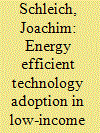

|
|
|
|
|
| Summary/Abstract |
This paper studies the adoption of high-cost, medium-cost, and low-cost energy efficient technologies (EETs) by income categories in eight European Union countries, relying on demographically representative household surveys carried out simultaneously among about 15,000 households in France, Germany, Italy, Poland, Romania, Spain, Sweden, and the United Kingdom. The statistical-econometric analyses allow the effects of income to differ by income quartiles in each country. For high cost EETs such as retrofit measures, the findings suggest that homeowners falling into the lowest income quartile exhibit lower adoption propensities than those falling into the highest income quartile. These findings provide some support for policies targeting “poor homeowners”, particularly in lower-income countries with a high share of owner-occupiers such as Poland and Romania. Further, differences in adoption propensities across income quartiles also exist for medium- and low-cost EETs such as appliances and light bulbs. Finally, analyzing factors related to homeowners receiving financial support for retrofit measures from governments or utilities suggests that differences in implementation rates between the highest and lowest income quartile would likely have been higher without such support schemes in place. For the United Kingdom (but not for other countries) these schemes appeared to have had a progressive effect.
|
|
|
|
|
|
|
|
|
|
|
|
|
|
|
|
|
|
|
|
|